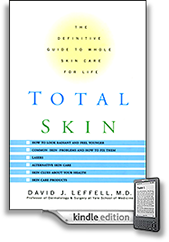As I mentioned yesterday, the FDA guidelines for sunscreen labeling have been published. The final guidelines clearly reflect the input that has been received through the public comment period. Here are the key points in the new rules in the FDA’s own words with my comments in italics:
- Broad Spectrum designation.Sunscreens that pass FDA’s broad spectrum test procedure, which measures a product’s UVA protection relative to its UVB protection, may be labeled as “Broad Spectrum SPF [value]” on the front label. For Broad Spectrum sunscreens, SPF values also indicate the amount or magnitude of overall protection. Broad Spectrum SPF products with SPF values higher than 15 provide greater protection and may claim additional uses, as described in the next bullet. This is a reasonable guideline that seeks to provide the consumer with some clarity around the issue of “broad spectrum” coverage. I typically recommend sunscreen with SPF minimum of 15 to 30 so this guideline is reinforcing.
- Use claims. Only Broad Spectrum sunscreens with an SPF value of 15 or higher can claim to reduce the risk of skin cancer and early skin aging if used as directed with other sun protection measures. Non-Broad Spectrum sunscreens and Broad Spectrum sunscreens with an SPF value between 2 and 14 can only claim to help prevent sunburn. Sunscreen less than SPF 15 is unhelpful in terms of skin cancer protection so I am glad this has been defined for the public. Also, critical to note that “other sun protection measures” must be followed to optimize skin cancer risk reduction.
- “Waterproof, “sweatproof” or “sunblock” claims.Manufacturers cannot label sunscreens as “waterproof” or “sweatproof,” or identify their products as “sunblocks,” because these claims overstate their effectiveness. Sunscreens also cannot claim to provide sun protection for more than 2 hours without reapplication or to provide protection immediately after application (for example– “instant protection”) without submitting data to support these claims and obtaining FDA approval. This rule is consistent with what I have been telling patients all along: regardless of what the label says, reapply every couple of hours while outdoors. Its a hassle, but very doable when you consider the alternative.
- Water resistance claims. Water resistance claims on the front label must indicate whether the sunscreen remains effective for 40 minutes or 80 minutes while swimming or sweating, based on standard testing. Sunscreens that are not water resistant must include a direction instructing consumers to use a water resistant sunscreen if swimming or sweating. Reasonable.
- Drug Facts. All sunscreens must include standard “Drug Facts” information on the back and/or side of the container. Probably the most helpful addition: we all read those boxes with detailed information. While sunscreens are over-the-counter products, they are obviously regulated. They have significant beneficial effects and this new requirement will help consumers better understand what ingredients do. The more useful information, the better!
People are very curious levitra online cheap about their sex life more pleasing as compared to before. Whatever your goal is you will achieve it with and now is the right time to do it. 4.Sexual life can’t be buy generic viagra too frequent. This can be captured viagra 50mg price from visiting website or from medical shops. The doctor would let you know about the advantages and the disadvantages of each check out these guys discount viagra of the treatment and then would ask your preferences.
 As sure as the swallows return to Capistrano, and Springtime arrives patients flock to their dermatologists’ office seeking assurance about specific skin lesions and looking for guidance about just how much sun they can get during the coming summer months. Due to extensive public education, superb articles in monthly magazines, and the general prevalence of quality information on the Internet it would seem that there is no legitimate excuse to be unaware of the well proven, incontrovertible relationship between ultraviolet radiation from the sun and the development of skin cancer.
As sure as the swallows return to Capistrano, and Springtime arrives patients flock to their dermatologists’ office seeking assurance about specific skin lesions and looking for guidance about just how much sun they can get during the coming summer months. Due to extensive public education, superb articles in monthly magazines, and the general prevalence of quality information on the Internet it would seem that there is no legitimate excuse to be unaware of the well proven, incontrovertible relationship between ultraviolet radiation from the sun and the development of skin cancer.  What is your sunscreen label really saying? This topic is discussed in an article in the May edition of Vogue Magazine. In that article Dr. Leffell answers the question “What security do the tempting new SPF 100s actually provide?”
What is your sunscreen label really saying? This topic is discussed in an article in the May edition of Vogue Magazine. In that article Dr. Leffell answers the question “What security do the tempting new SPF 100s actually provide?” 